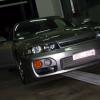Noise. Need Opinion
Announcements
-
Similar Content
-
Latest Posts
-
That R31 was so cool. Only did Orange Park once. Scared the hell out of me.
-
By GoHashiriya · Posted
Selling my TE37SLs since I've switched to smaller wheels. They're for sale in Japan but it's pretty simple to send them overseas; USA excluded, since JPPost isn't sending there at the moment. Specs Front: 18x9.5j +22 5x114 Rear: 18x10j +20 5x114 Price: 320,000 JPY/ 3,285 AUD (current FX rate) Condition: a few scratches here and there, no bends, distortions or cracks. Tires will not be included for international buyers, I'll get them dismounted before shipping. They're currently listed on yahoo auction and will be shipped in Japan with the tires if they sell here. Shipping costs to Aus: EMS (1-2 weeks): AUD 1,175 (current FX rate) Sea (2 months): AUD 460 (current FX rate) -
The alloy coolant reservoir has a sight glass, so as long as I can see coolant in the sight glass it's GTG, as for PS, it isn't anything catastrophic if it gets low, and as it hasn't lost a drop since I have owned the car I cannot see it being an issue, even after putting the "big block" 2.5 in....LOL The only time it gets slightly messy is at oil changes, as the oil filter sits above the frame, and I need to use a plastic bottle with its bottom cut off to catch the flow when loosening the filter
-
Good on you for taking on the job, but it is a big one. Even if you have bolt on manifold and turbo, you will need: Post throttle pressure source to boost controller to wastegate (and FPR, and ECU/MAP sensor) Pre throttle pressure source to top of BOV(s) Oil feed - you can take that from the standard port in the middle of the block Oil return to block under the turbo - this is much trickier than it seems to route a decent/wide pipe past the manifold. You really can't use rubber hose because it is way too hot there, and also the oil out of the turbo core is a bit frothy so it needs to have a decent diameter Water feed - you can take that from the standard port in the rear of the block. Water return - mine runs to a T into the heater box return, just make sure you don't create a high point making bleeding hard. All of those lines should use 200 series style teflon braided hose with heat shielding because everything needs to be routed past the manifold. Also a turbo beanie is a really good idea to minimise the chance of the car catching fire (under bonnet lining in particular) You also need to decide a cam cover breathing solution as well, will you vent externally via a catch can (probably illegal) or return to the intake (plumbing required and can oil up everything over time) Keep in mind the intake and exhaust piping in the engine bay will be custom so you either need to be able to fab ally and steel or have someone you can get a car that isn't running to. Get the wideband fitting welded into the dump pipe at the same time. Also, just my opinion, a screamer pipe attracts attention and doesn't add power, I'd plumb it back if you want to be allowed to keep the car on the road. BTW do you know anything about how healthy the motor is, and what power you are targeting? Doubling or tripling the factory power on an unknown motor is a little risky. Also fuel system will need some attention (pumps, high current hanger, direct power and earth feed, injectors etc)







Recommended Posts
Create an account or sign in to comment
You need to be a member in order to leave a comment
Create an account
Sign up for a new account in our community. It's easy!
Register a new accountSign in
Already have an account? Sign in here.
Sign In Now